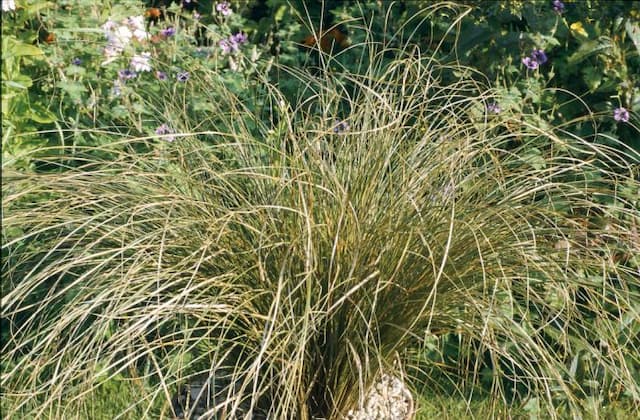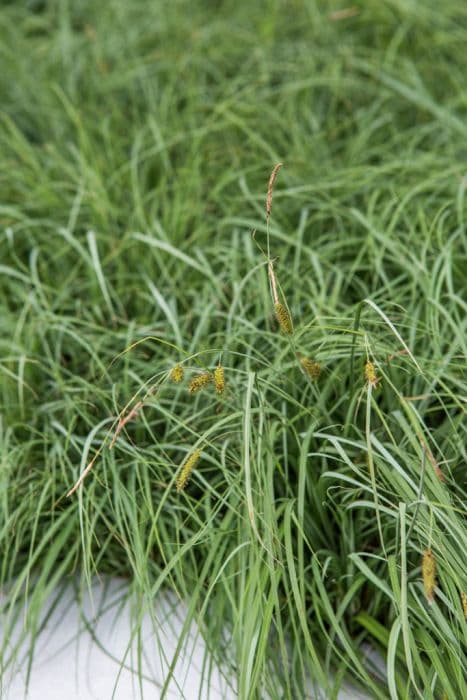Bowles Golden Sedge Carex elata 'Aurea'











ABOUT
The plant known as Bowles’ golden sedge is a visually striking ornamental grass that boasts vibrant yellow-green foliage. Its leaves are narrow, with a fine texture that lends a soft, almost feathery appearance. The yellow of the leaves has a golden sheen, especially when the plant is positioned where it can catch the light, which can illuminate the whole plant with a bright, glowing effect. Bowles’ golden sedge forms a dense, grassy clump, with its leaves arching outwards and slightly drooping towards the tips, providing a lush, tufted look. This plant is often prized for the bright color it adds to gardens and landscapes, creating a contrast against darker green plants or serving as a focal point amid a variety of other garden elements.
About this plant
 Names
NamesSynonyms
Bowles' Golden Sedge, Golden Sedge, Golden Carex.
Common names
Carex elata 'Aurea'.
 Toxicity
ToxicityTo humans
Carex elata 'Aurea', commonly known as Bowles' golden sedge, is not known to be toxic to humans. There are no well-documented symptoms of poisoning or toxic reactions from ingesting any part of this plant. As with any plant, individuals may have different sensitivities, so it is always advisable to avoid ingesting plants not meant for consumption.
To pets
Bowles' golden sedge is not recognized as a toxic plant to pets, including cats and dogs. There is no documented toxicity resulting from pets ingesting any part of this plant. However, pets may sometimes have individual reactions or sensitivities, so it is generally recommended to prevent pets from eating ornamental plants.
 Characteristics
CharacteristicsLife cycle
Perennials
Foliage type
Evergreen
Color of leaves
Yellow-green
Flower color
Brown
Height
2-3 feet [61-91 cm]
Spread
1-2 feet [30-60 cm]
Plant type
Herb
Hardiness zones
5
Native area
Europe
Benefits
 General Benefits
General Benefits- Ornamental Appeal: Carex elata 'Aurea', commonly known as Bowles' golden sedge, has striking golden-yellow foliage that adds color and visual interest to gardens and landscapes.
- Low Maintenance: It requires minimal care once established, making it a convenient choice for gardeners with limited time.
- Soil Stabilization: The root system can help stabilize soil, reducing erosion in areas such as slopes or banks near water bodies.
- Habitat for Wildlife: Provides shelter and nesting material for birds and small animals.
- Water's Edge Beautification: Ideal for planting around ponds, streams, and other water features where it can thrive in moist conditions.
- Seasonal Interest: Offers year-round interest with evergreen foliage in milder climates, and seasonal color changes in colder regions.
- Texture Contrast: Its fine, arching leaves add a contrasting texture when planted among plants with broader leaves or different growth habits.
- Drought Tolerance: Once established, it can withstand periods of drought, though it prefers consistent moisture.
- Adaptable to Containers: Suitable for growing in containers, which allows for flexibility in placing it in various garden designs and on patios.
- Complements Water Features: Enhances the aesthetics of water gardens and helps to create a naturalized look.
- Divides Easily: Can be easily divided to create new plants, making it cost-effective and allowing gardeners to propagate more plants for use in other areas.
 Medical Properties
Medical PropertiesThis plant is not used for medical purposes.
 Air-purifying Qualities
Air-purifying QualitiesThis plant is not specifically known for air purifying qualities.
 Other Uses
Other Uses- Carex elata 'Aurea', commonly known as Bowles' golden sedge, can be used in crafting for basketry. Its durable leaves provide an interesting texture and color for handwoven baskets.
- The sturdy and upright form of Bowles' golden sedge makes it a natural choice as a screen or backdrop in landscape photography, offering a lush golden hue throughout the seasons.
- Bowles' golden sedge is often integrated into living walls or green facades in urban garden designs for its structural interest and year-round foliage color.
- Artists may use the dried foliage of this plant in mixed-media art projects to add an organic, textural element to their works.
- In garden ponds, Bowles' golden sedge can be planted along the margins to provide habitat for pond wildlife such as frogs and dragonflies.
- This plant's dense root system can function in erosion control along stream banks or areas prone to heavy rainfall, helping to prevent soil loss and stabilize the ground.
- Bowles' golden sedge is sometimes used in sensory gardens, where its distinct foliage color and texture offer a unique sensory experience.
- The grass can act as a natural mulch if clippings are left on the ground, helping to retain soil moisture and suppress weeds.
- When planted en masse, Bowles' golden sedge can serve as a low-maintenance ground cover in large landscape areas due to its clumping habit.
- For outdoor gatherings or events, the striking foliage of Bowles' golden sedge can be used as a base in floral arrangements or table centerpieces.
Interesting Facts
 Feng Shui
Feng ShuiThe Bowles' golden sedge is not used in Feng Shui practice.
 Zodiac Sign Compitability
Zodiac Sign CompitabilityThe Bowles' golden sedge is not used in astrology practice.
 Plant Symbolism
Plant Symbolism- Refinement and Elegance: The Carex elata 'Aurea', commonly known as Bowles' golden sedge, features delicate, arching foliage that creates an elegant appearance, symbolizing an air of refinement and grace in a garden setting.
- Adaptability: As a plant that thrives in both wet and dry conditions, Bowles' golden sedge represents the ability to adapt to varying environments and situations.
- Prosperity and Wealth: The golden-yellow color of the foliage can symbolize wealth and prosperity, making it a plant that might be gifted to wish someone financial success or used in gardens to attract positive energy related to abundance.
- Vitality: This sedge's vibrant golden hue is also emblematic of vitality and life energy, promoting a sense of exuberance and wellbeing.
 Water
WaterThe Bowles' Golden Sedge prefers consistently moist soil, so water the plant when the top inch of soil feels dry to the touch. Generally, this means watering once or twice a week, but the frequency can vary depending on weather conditions and the plant's environment. Use approximately one to two gallons of water per week, making sure it's applied directly to the base of the plant to keep the foliage dry and prevent fungal diseases.
 Light
LightBowles' Golden Sedge thrives in partial shade to full sun. It does best when provided with morning sunlight and afternoon shade, or dappled sunlight throughout the day. Avoid placing it in areas with intense midday sun, which can scorch its delicate leaves.
 Temperature
TemperatureBowles' Golden Sedge can tolerate a range of temperatures, but it grows best when the temperature is between 50 and 75 degrees Fahrenheit. It can survive temperatures as low as 20 degrees Fahrenheit, but growth may slow or stop. Be cautious of temperatures exceeding 90 degrees Fahrenheit, as this may stress the plant and hamper its vigor.
 Pruning
PruningPruning Bowles' Golden Sedge is primarily to remove old or damaged foliage and maintain its attractive appearance. Lightly prune in the spring, cutting back any winter-damaged leaves to keep the plant tidy. The best time for a fuller prune is in late winter or early spring before new growth starts.
 Cleaning
CleaningAs needed
 Soil
SoilBowman's Golden Sedge prefers moist, well-drained soil rich in organic matter with a slightly acidic to neutral pH of 5.5 to 7. A mix composed of loam, peat, and sand in equal parts is ideal for proper root growth and water retention.
 Repotting
RepottingBowman's Golden Sedge thrives in consistently moist conditions and does not need frequent repotting. It is typically repotted every 2 to 3 years, or when the plant outgrows its current container.
 Humidity & Misting
Humidity & MistingBowman's Golden Sedge requires high humidity levels to mimic its natural wetland habitat. Maintaining humidity levels of 60% or above is conducive to its growth.
 Suitable locations
Suitable locationsIndoor
Place Bowman's Golden Sedge in bright, indirect light with high humidity.
Outdoor
Plant Bowman's Golden Sedge in full sun to partial shade, keep soil moist.
Hardiness zone
5-9 USDA
 Life cycle
Life cycleBowles' golden sedge (Carex elata 'Aurea') begins its life cycle with seed germination, usually occurring in moist, well-drained soils in partial to full shade. Upon germination, the seedling emerges and develops into a juvenile plant with a tuft of distinctive, yellow-green foliage. As the plant matures, it forms dense, grass-like clumps due to its rhizomatous growth habit, where it can reach its typical height and spread. Periodically, it produces flowering stems called culms, bearing brown flower spikes, which if pollinated, set seed for dispersal and the continuation of its lifecycle. The plant typically enters a period of dormancy during the colder months, with its foliage dying back, only to resprout from its hardy rhizomes with the arrival of warmer spring temperatures. Throughout its life, Bowles' golden sedge may also undergo vegetative reproduction through division, enabling the spread and establishment of new plants.
 Propogation
PropogationPropogation time
Spring-Early Summer
The Bowles' Golden sedge (Carex elata 'Aurea') is most commonly propagated by division, which is executed during late winter or early spring just as the plants are emerging from dormancy. To propagate by division, carefully lift the entire clump of sedges out of the ground with a garden fork, ensuring minimal damage to the root system. Once extracted, use a sharp knife or spade to cut the clump into smaller sections, each with a portion of the roots and several shoots. These divisions can then be immediately replanted into prepared soil, ideally spaced about a foot (approximately 30 centimeters) apart to allow adequate room for growth. Water the new plantings thoroughly to help establish the divisions, which will naturally grow to form new clumps over the following season.







![Japanese sedge [Everest]](/_next/image?url=https%3A%2F%2Fplants-admin.emdemapps.com%2Fimages%2Fplants%2F%2Fimages%2F604b5b6de0548.png&w=640&q=75)

